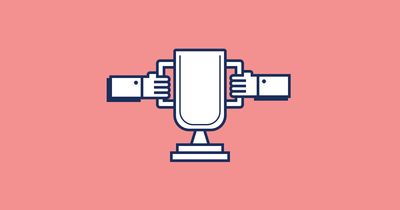
Winback campaigns: Examples, strategies, and best practices
-
Messaging and AutomationUpdatedPosted:
On this page
Have you ever lost touch with a friend from college only to reconnect years later? Or perhaps you’ve rediscovered your favorite t-shirt in the back of your drawer. Everyone goes through phases in their life, and chances are, you’ve experienced a winback campaign in one way or another.
A winback email campaign is a series of messages aimed at re-igniting customer engagement. You send these email sequences to past users who haven’t purchased from you in a while, with the hope of bringing them back into an active user segment.
At the very least, you’ll clean your list of truly inactive subscribers to maintain high engagement rates.
A classic example of a winback email is from Duolingo. You’ll find many winback emails using “we miss you” language and talking about how it’s been a while since you’ve signed in.
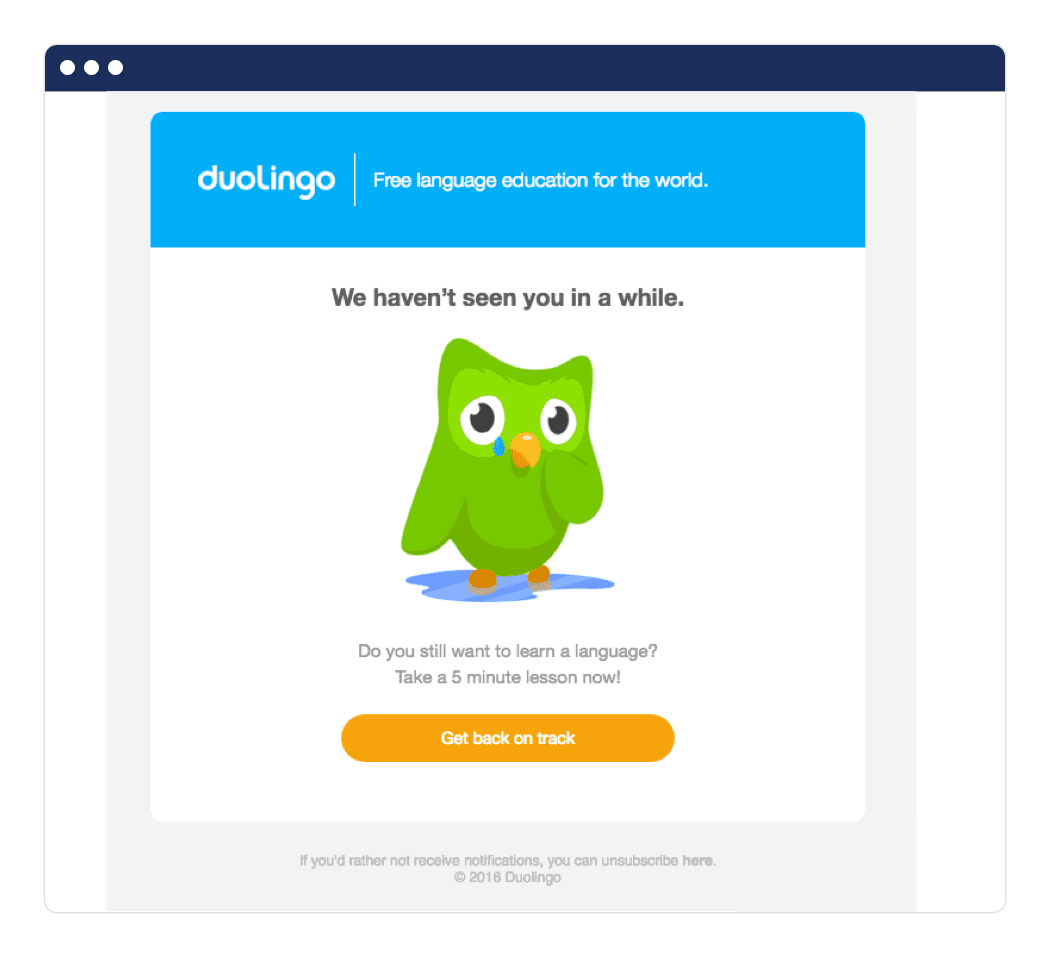
Just because a user canceled their account or stopped buying from you, doesn’t mean all hope is lost. Research suggests that winback email campaigns are powerful strategies for re-energizing lapsed customers and increasing your revenue, without going back to the top of the lead generation funnel.
Here are a few facts and figures to inspire you to create a winback campaign strategy of your own:
- 45% of subscribers who receive a winback campaign read future communications
- 25% of winback campaign subscribers open messages up to 300 days after the initial winback emails
- It costs five times more to attract a new customer than retain existing ones
These numbers are great, but what if we run a little exercise to measure the potential impact a winback campaign could have on your business? To do this, you’ll need the following numbers:
- Number of inactive or lapsed subscribers and customers
- Expected conversion rate
- Average order value
You can review winback email benchmarks by industry here, but we’ll assume an average conversion rate of 0.89% and an average order value of $62.
We’ll dive more into list segmentation strategies later, but let’s start simply. Let’s say you have 20,000 inactive email subscribers that you’d like to target.

Using the RFM matrix to segment subscribers
Segmentation is a powerful strategy in all of your email campaigns. Segmented emails have on average, 14% higher open rates and 101% higher click-through rates than non-segmented emails. If it works while users are engaged, then why stop there?
Segmenting your disengaged subscribers and customers helps you deliver a more relevant email series, which will improve your chances of winning them back. Since winback email campaigns are targeted at existing customers, it’s a good idea to use the RFM matrix.
The RFM matrix has three components:
- Recency – How long has it been since they’ve purchased/ been active?
- Frequency – How often did they purchase from or engage with your company?
- Monetary value – What was their average order value?
Comparing these three variables helps you understand how engaged a user was, and how you should approach them. For example, sending a winback email with an emotional “we miss you” to a customer that only purchased once three years ago would feel a little off. It would be like a person you had one date with years ago professing their undying love for you out of the blue!
Categorizing users in an RFM matrix also helps you decide who you should create sequences for, and when you should just cut your losses. The example matrix below categorizes customers into six categories, ranging from high-priority “hero customers” to low priority “lost causes.”

A customer’s rank depends on their order frequency within a year (vertical column), when they placed their last order (horizontal column), and their average order value (low, medium, or high).
If you’re creating your very first winback series, start with the “hero customers.” These are people who were very engaged or big spenders, and lapsed within the past six months. Since they seemed to have enjoyed your company before, and haven’t been gone long, the top left quadrant of the matrix represents your best chance for higher conversion rates.
Once you’ve created, deployed, and perfected your “hero” customer winback sequences, you can move on to customers who have a smaller likelihood of re-engaging.
What to include in your winback email campaign strategy
After you’ve segmented your inactive subscribers for winback campaigns, it’s time to strategize on your messages. Below, we’ll explore a five-part winback email campaign strategy to follow, including examples to use as inspiration.
Hello email
The hello email is your winback kickoff, and what you use to begin reconnecting with lapsed customers.
What it needs to accomplish:
- Let customers know what’s new. Have there been product improvements since the person left? Use this email to let them know. Bonus points if the updates are related to why the user left in the first place.
- Remind customers why they chose you the first time. What is it about the company that draws people to you? Remind users of the benefits or positioning that won them over before.
- Honor their previous engagement. Recognize the past relationship, especially if they were a highly-engaged or long-standing user.
- Recall why they left. If you have data available about why a customer cancelled their subscription, you can use winback emails to remind them. Owning up to what was wrong before, and how you’ve improved can be powerful.
How to measure it:
Since this is your first message to the user in some time, or at least your first specific effort at winning them back, pay attention to open rates.
How to personalize it:
- Adjust emotion to match previous relationships. Did you have a long or short relationship with the customer? You may use more of an emotional writing tone with loyal subscribers.
- Address their previous purchase category or industry. If you have different customer segments across product lines, industries, or use cases—try personalizing emails to match.
Examples:
Dropbox knows that sometimes, there’s nothing more daunting than a blank page. That’s why their hello winback email highlights templates along with the headline: “Here’s what you’re missing.” The email subtly addresses a decline in engagement, and catches readers’ attention with the subject line “21 reasons to give Dropbox another try.”

Chime also uses its winback email to address why you should give their company another shot. The email below, which came under the subject line, “What Chime Members Are Saying,” is full of social proof. The core of the email features quotes from chime members that highlight top benefits.
They’ve also lowered the mental barrier to getting started by adding the line, “It takes just two minutes to become a Chime member (wink wink).”

Incentive
If a simple hello and refresher on your company’s benefits aren’t enough to get the ball rolling, you can move in with an incentive.
What it needs to accomplish:
- Be exclusive. Don’t send the same promotional email that everyone gets. Highlighting the exclusivity (or limited time) of an offer can inspire users to act now.
- Be worthwhile. A ten-dollar discount on a thousand dollar item isn’t going to move the needle. If you’re not comfortable offering a discount, think of other ways to make the offer enticing, such as unlocking a feature or granting early access.
How to measure it:
At this point, you’ve introduced a clear reason for users to come back. Therefore, your primary goals are conversions, or at least click-throughs.
How to personalize it:
- Incentivize their previous favorites. Do you have segments who preferred one product over another? If so, focus your incentive on what you already know they like.
- Experiment with discount structures. One study found that dollar amount-off discounts 2X outperformed percentage-off offers. Run A/B tests to see what resonates with your audience.
Examples:
Blue Apron serves up its incentive email with a clear headline and CTA button. The subject line “Come on back – we made dinner easier! 😋” and the headline “Delicious Dinner Faster” both focuses on the convenience of the service. The CTA also clearly states the $30 discount offer.

CLEAR also chooses a single benefit to highlight throughout their email. The subject line acknowledges the lapsed time by saying: “[Insert name here], we’re ready to wow you again.” The email also includes the incentive: “Zip through security with a year of CLEAR for only $119.”

Asking for feedback
There are two possible outcomes with each winback sequence—a customer comes back, or they don’t. Either way, you stand to benefit from getting feedback about their perspective.
What it needs to accomplish:
- Learn why they left (or are staying away). If customers simply drifted away (as opposed to canceling their account outright), you may not have had a chance to do an “exit survey.” Asking customers about their experience, and what caused them to leave, can help you improve in the future.
- Let customers know you value them. You want to be on good terms with every customer, even if they’re no longer a fit. Let subscribers know why you want feedback, and how you plan to implement it to improve your service.
How to measure it:
The more responses, the better. Pay attention to response rates and click-through rates. If your CTR is substantially higher than your response rate, you may be asking too much in the survey, causing people to leave.
How to personalize it:
- Alter the survey if you know the cancellation reason. If you do ask customers why they chose to leave when they cancel their subscription, don’t ask for more feedback.
- Consider what you need to know from each segment. Asking for feedback is your chance to learn about user issues straight from the source. Do you have unanswered questions about goals or motivators for a particular segment? Use this opportunity to fill in your knowledge gaps.
Examples:
Scoot uses a simple winback feedback email with the subject line, “we’d love your help.” Their copy lets the reader know why they’re getting the email (they haven’t travelled with Scoot in a while) and the purpose (to improve the rider experience).

CLEAR has earned another spot in the post with their feedback winback email example. This message is a letter from the CEO and outlines their company mission of “building an experience that is simple, smart, and secure.”
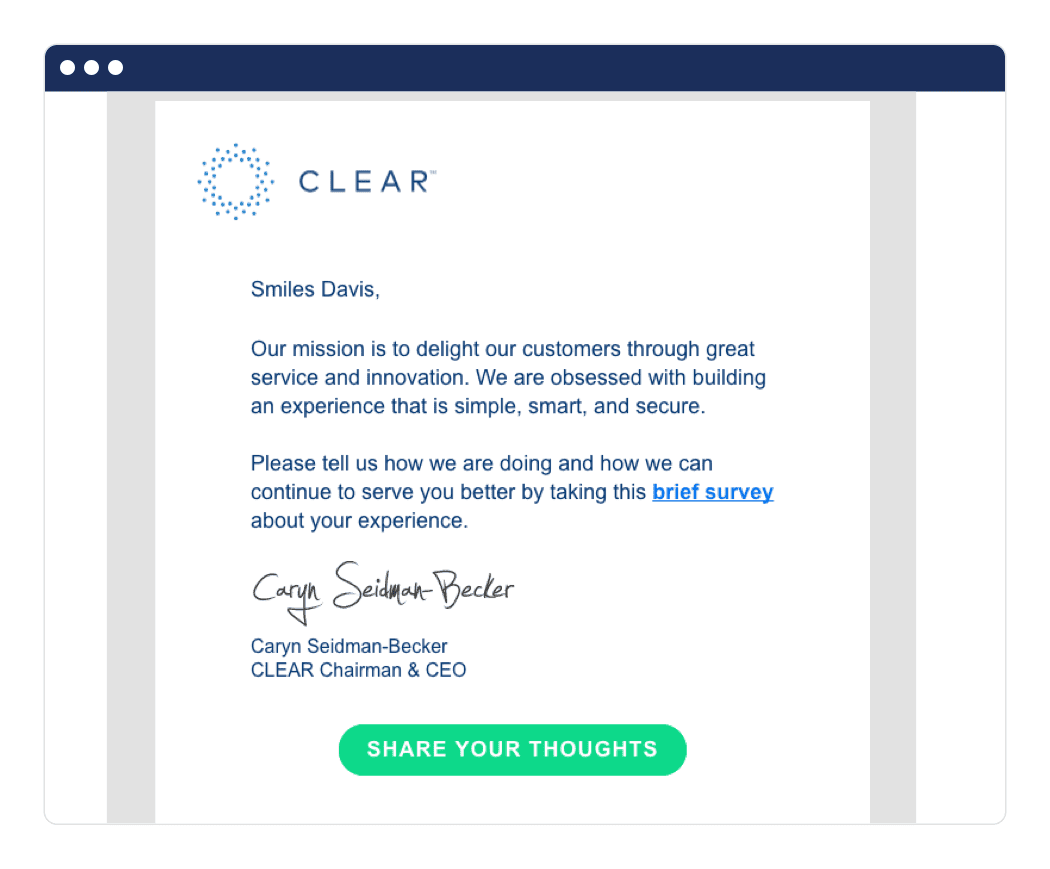
Last chance
There comes a time when you need to wrap up your winback campaign, and send the last chance message. This email could focus on the fleeting nature of the incentive, or directly ask subscribers to opt-in to continue to receive messages.
What it needs to accomplish:
- Remind users about the incentive. If you have a winback offer, send this “last chance” email as a reminder to claim their discount.
- Ask subscribers if they want to remain on your list. To gauge who wishes to stay on your list and who isn’t engaging, you can ask inactive readers to opt-in to staying. This method can help you keep your list clean, while also re-engaging some customers that may have forgotten about you.
How to measure it:
Obviously, you want the click-through rate of people opting to remain or the conversion rate of your offer as high as possible. It’s also worth comparing the difference in open rates and CTR or conversion rates, since a big difference could signal issues in your offer or email. This metric is called the click-to-open-rate.
How to personalize it:
-
Reserve discounts for those who have opened winback emails. One
element to test in your winback email campaign is which last
chance message a person received based on their interaction with
previous winback emails.
- Follow your data. Use segmentation when possible to make your messages more targeted and relevant. Group subscribers by their customer segment, how long ago they lapsed, or how engaged they were previously. In the example below, there’s a “VIP” user segment of highly-engaged customers.
- Start with your recently loyal customers. The group most likely to come back are those that bought from you frequently, and recently. Start your efforts there.
- Remind customers why they loved you. Something about your company encouraged the user to try you once, so bring those positive qualities forward.
- Let them know what you’ve improved. Your latest updates or additions may be enough to entice someone to give you another shot, so let them know what you’ve been up to. FreshBooks lets users know there have been 34 updates since they left.
- Test your offers to find the best fit. Every audience may react to offers differently. If you’re presenting a discount, try dollars-off, percent-off, or simply the price after discount. You can also offer additional time, stepping down to a free plan, or getting early access. In the examples below, you can see where companies choose different offer structures.
- Stepping down is better than stepping away. Taking a small break is better than losing the customer relationship entirely. Highlight your email preference center, like the one below, to let users customize communications, or introduce a lower-tiered plan.
For example, if someone opened your offer email, but didn’t convert, you could send them a time-bound “last chance” discount. If, however, the offer didn’t catch their attention the first time, you may have better luck with an emotional “I guess this is goodbye” style email.
Examples:
Framebridge used their “last chance” message to check if subscribers wanted to remain on their list. The company opted for a more emotional subject line of “goodbyes are hard…” and let the reader know they received this message because they haven’t been opening emails.
The design of the email is simple text, with a can’t-miss red CTA button stating: “Wait, keep me on the list.”

To create a little more pressure on the winback offer, CBS All Access includes a countdown timer in their last chance email. The vital information—the countdown timer, discount, and CTA button—are all at the top of the message, so that readers can see it all at-a-glance.
The subject line echoes the urgent tone with “last chance to get
1 month FREE!”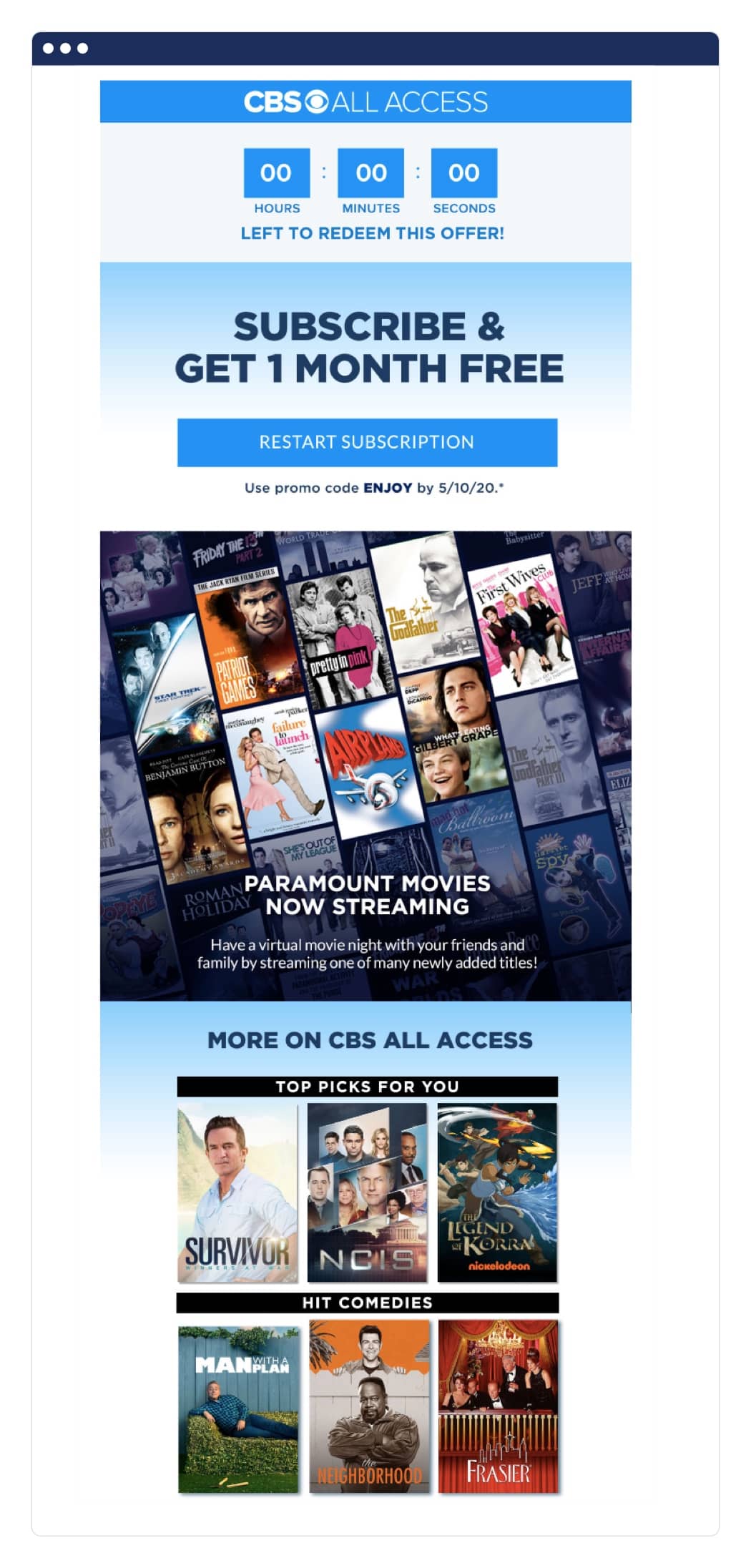
Winback campaign best practices and considerations
For SaaS companies
You could have a post-free-trial and post-cancellation winback campaign.
Companies with free trials and monthly subscriptions, like SaaS, could have multiple winback moments. First, you may offer a free trial extension or an upgrade if someone doesn’t convert during your free trial. Second, you may try to win users back that have canceled their paying account.
Atlassian sends an email once the free trial has ended, extending an offer to remain on their “free” tier. This tactic lets users “step down” as opposed to leaving entirely, and allows Atlassian to maintain contact in hopes of an upgrade in the future.
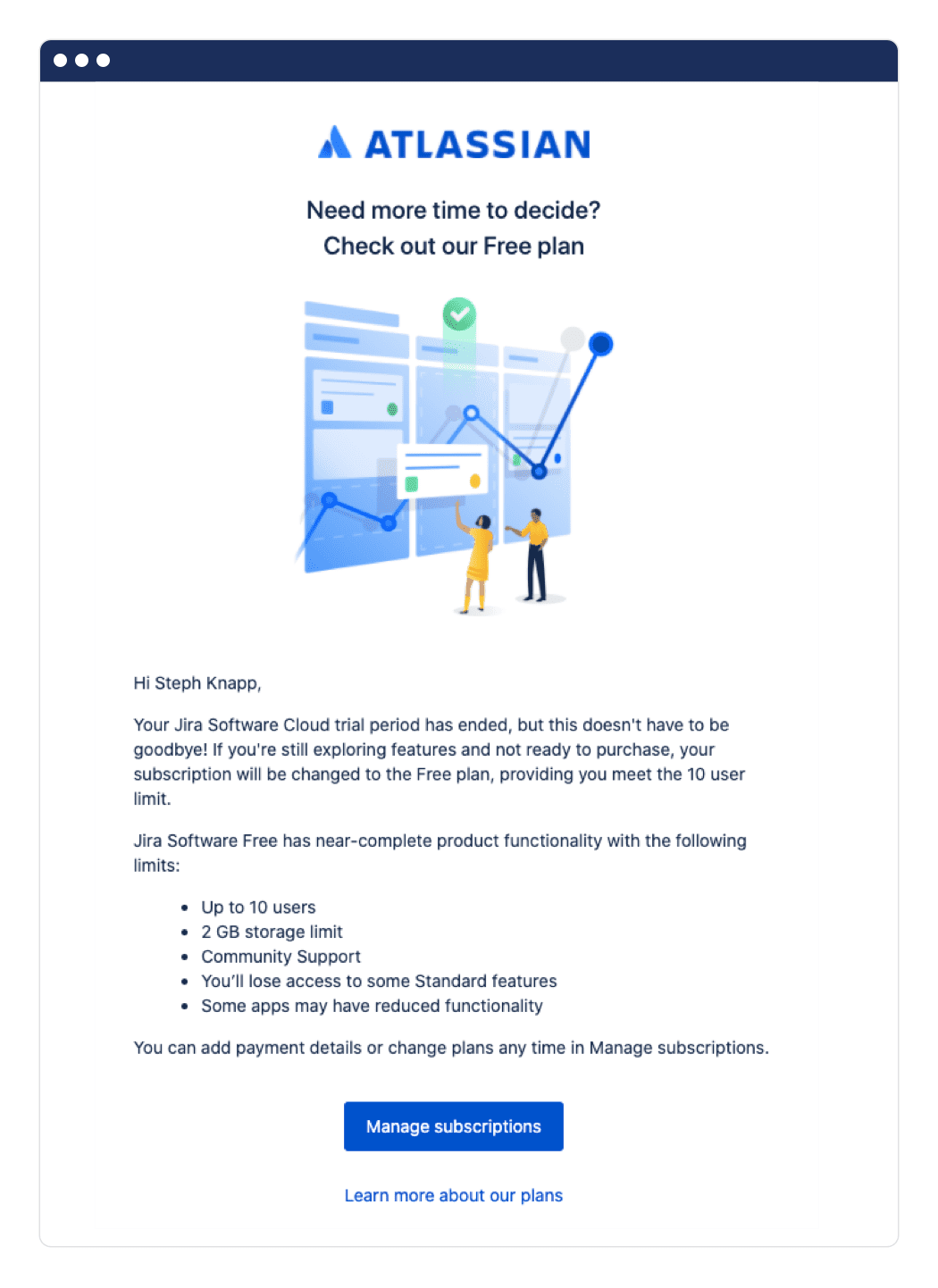
Audible also has options on their website for users to pause or reduce their subscription. The offer to reduce your account down to one Audible credit a month, and cut the monthly cost in half, is only available once a person is a few steps into cancellation. By introducing this exclusive offer at this critical time, they may be able to win back the customer before they’ve fully left.
If a customer has canceled their service, you may come back later with an incentive. FreshBooks sends an email with the headline “Take FreshBooks for Another Spin” and introduces a discount if you pre-pay for six months. They also take time to highlight some recent updates.
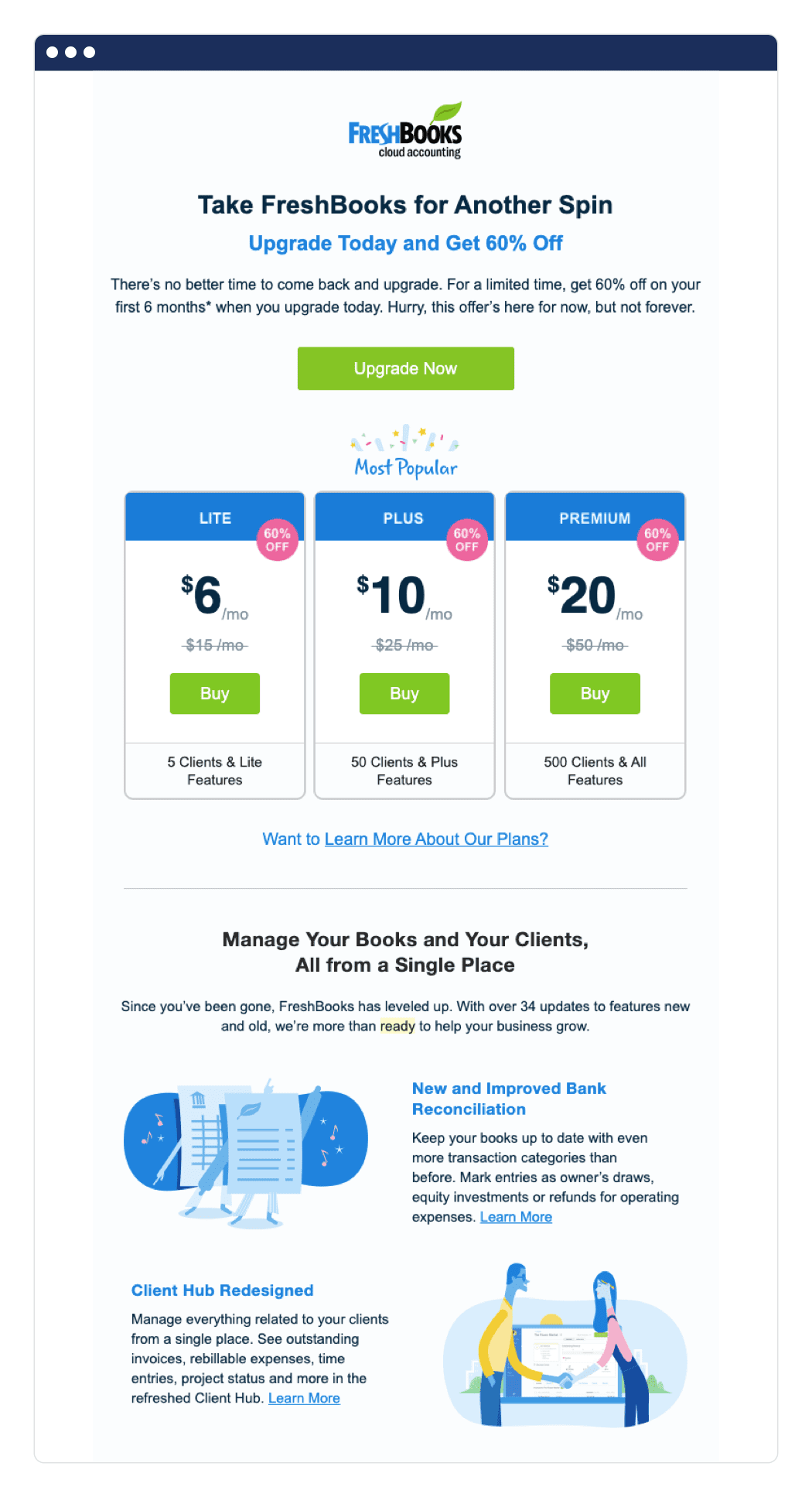
Audible also presents an offer to get 45% off your first three months back with the service. The email clearly outlines the offer, has a “resume your membership” CTA, and lists a few benefits of the service.
Audible also personalizes the email by including titles the user has expressed interest in, which may reignite their interest.
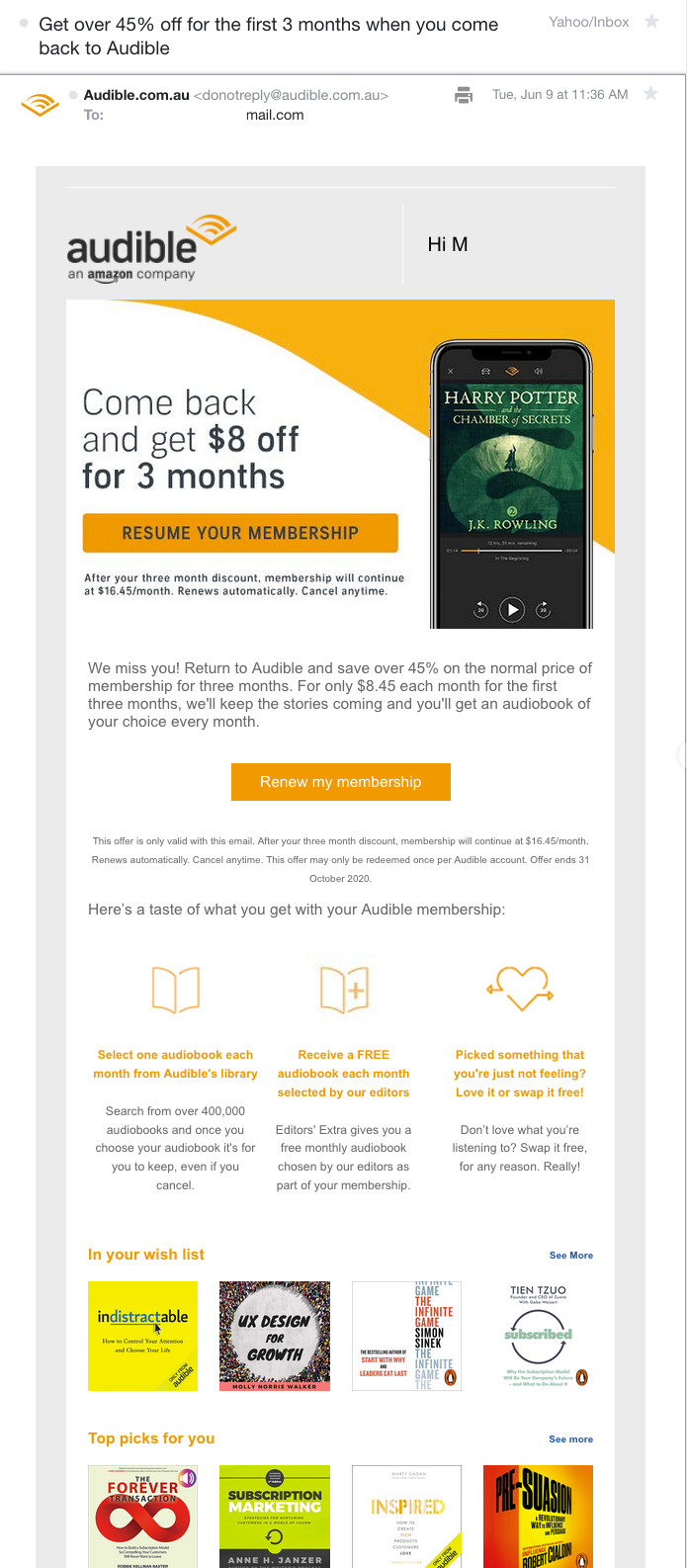
For e-commerce companies
Send winback emails based on when customers purchased.
One element of context to keep in mind for your winback campaign is timing. For example, do some customers only purchase seasonally? Are they more active around particular sales or launches? If so, send winback messages around these times to act as a timely reminder.
You can also customize e-commerce winback emails by highlighting previous preferences or purchases. For example, Overtone sends a winback email with the subject line “we miss you :(“ that highlights solutions for brown hair, based on a previous purchase. The message also came two months after the initial purchase, which could be the length of time the company estimates that repurchase is needed.
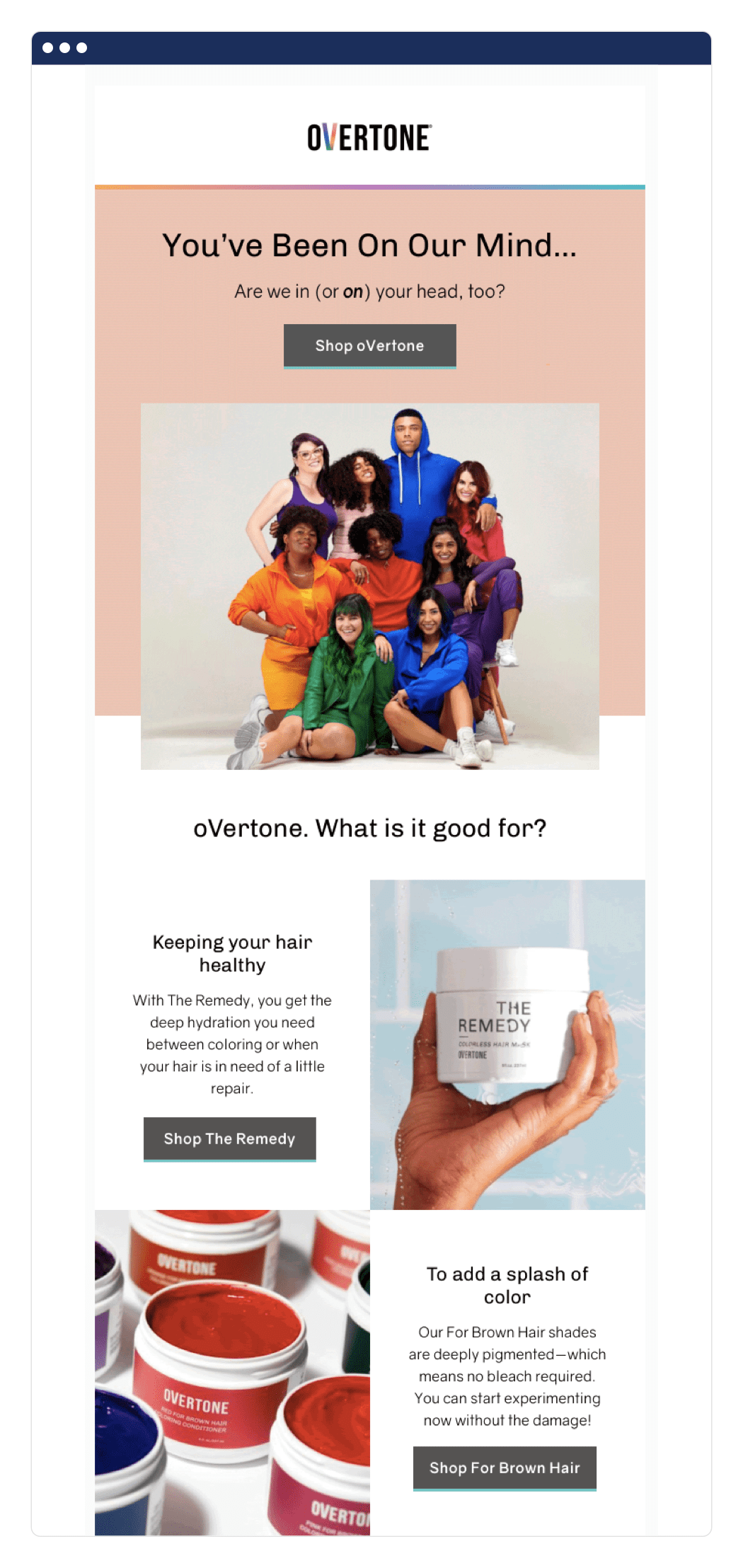
For marketplace companies
Aim to understand why each party left.
When you’re approaching a winback strategy for a marketplace company, consider both buyers and sellers. Focusing on learning why each segment leaves will help you tailor your two sequences in the future.
Including a one-question survey on your cancellation page or a feedback email for lapsed users helps you gather data. For example, YesInsights sends a simple text email with five common churn reasons. All a person has to do is click which applies to them, and then YesInsights can compile data on the most pressing issues.
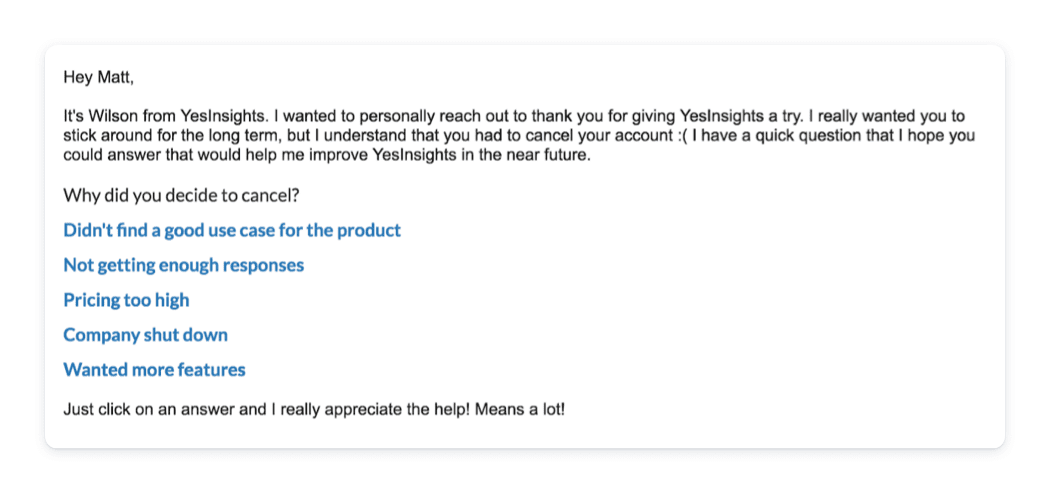
For everyone
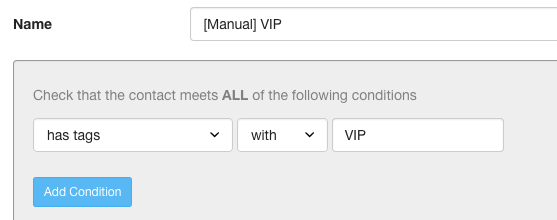
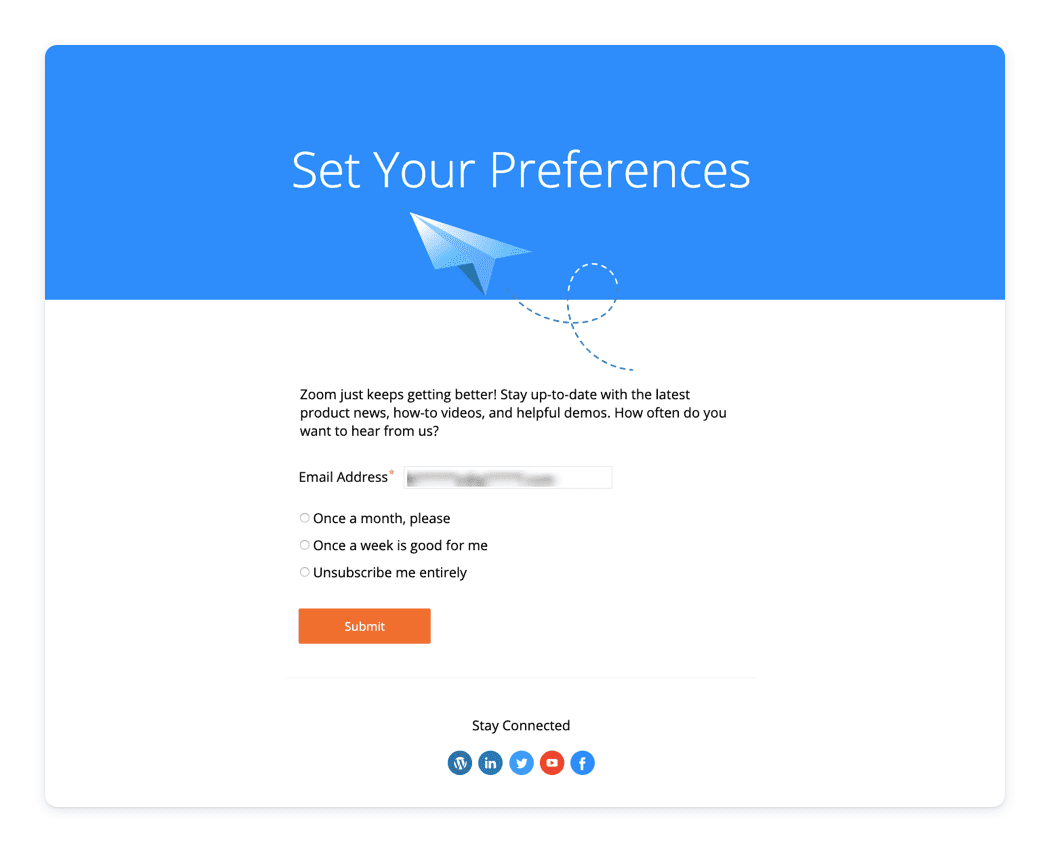
Your company’s relationship with customers is critical, and taking a few extra steps to rekindle lapsed users is worth the effort. By reminding users what they loved and what you’ve improved, you can reactivate customers and increase revenue without attracting a new audience.
Want to learn more about keeping customers engaged? Check out our guide to retention marketing here.
Want to send more personalized mobile and email messages to your users?
Learn moreCustomer story

How Vero helps Dribbble take full advantage of their customer data to improve personalization

